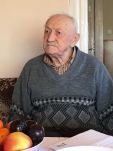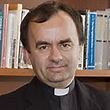Karen Treiger's Blog, page 9
August 22, 2019
My Soul is Filled with Joy – Finalist in PNWA, Nancy Pearl, Book Award
[image error]
The phone rang.
I thought – don’t answer the phone, if you hold answer while on the dock above Lake Washington, the chances that your phone will fall in the water are very high. You see, I have lost two phones to the lake and many members of my family have likewise have sacrificed their cell phones to the monsters that lurk beneath the surface of Lake Washington.
Well, I answered the phone.
But it was great news – I was informed that I am one of five finalists for the Pacific Northwest Writers Association, Nancy Pearl, Book Award. The winner will be announced on Saturday evening September 14th at the Pacific NW Writer’s Association Conference. I will not be at the dinner where this will be announced because it will still be Shabbat and I do not drive on Shabbat.
There are five finalists, so my chances of winning are 20% – not too terrible. But honestly, even if I don’t win, it is such an honor to be a finalist. The judges are librarians – and we all know what that means.
So stay tuned. I will let you know, win or lose!
August 11, 2019
Hunger – Tisha B’av – Diaries of David Sierakowiak
[image error]
“All day long I had nothing to eat but water (soup) in the kitchen. It’s more and more difficult for me to go on starving. In the past I was able to not eat all day and still hold on somehow, but now I’m an empty pot. I was so weakened by the lack of soup at school that I thought I would collapse.”
Saturday, July 19, 1941. Lodz. (p. 112 Dawid Sierakowiak – age 17)
******
Today we commemorate Tisha B’av – the Ninth of Av – a day of Jewish mourning. We read Jeremiah’s Lamentations as we mourn the destruction of two Temples, we fast and read poems of remembrance. Mostly, we try our best to sit in the darkness of Jewish history. So many tragedies – destructions, pogroms, crusades, inquisitions and of course our generation’s tragedy – the Holocaust.
I decided that today I must finish the Diaries of Dawid Sierakowiak that I first mentioned in a blog post on June 13, 2019. I wanted to finish reading the Diaries because I feel hungry and tired and a headache is slowly developing from fasting. I want to realize that what I am feeling is nothing compared to what Dawid or my in-laws, Sam and Esther, experienced during the Holocaust.
If there is one theme in Dawid’s many diary entries – it’s starvation in the Lodz ghetto. All he thinks about is food. Every few entries we hear of the rations that were given out.
Friday, March 27, 1942. “A series of rations has finally been issues. 3 kilos of potatoes, beets, sugar, margarine, coffee substitute, saccharine and Fruchstuppe [German fruit soup], and a ration of meat (30 dkg).
Many people are being deported. Only those employed in the workshops are exempted, but their families are deported if they are large. A certain percentage of clerks is also being deported.” (p. 150).
This deportation and so many others sent thousands of Lodz Jews sixty kilometers away to Chełmno. Here they were put in mobile vans with the exhaust pipe connected to the passenger section. The van drove out of town with its own carbon monoxide pumped into the cab. It would slowly asphyxiate the passengers. The dead would be dumped into pits outside of town. By the middle of 1942, approximately 30 such gas vans had been produced by a German car manufacturer for use at Chełmno. (Arad 11). By the date of Dawid’s diary entry – March 27, 1942 – the Chełmno killing vans had been functioning for three and a half months. Dawid’s mother was deported and murdered at Chełmno in September of 1942.
In total, 130,000 Jews were deported from Lodz and were murdered in Chełmno and Auschwitz. (p. 14).
The suffering seems never ending.
Wednesday, April 29, 1942. “It’s really bad a home. There is no fuel, and we are eating our May rations of potatoes in April. No one knows what will happen in May. Nothing good, that’s for sure. Again, I don’t have any will, or rather any strength, for studying. I want to do something, but everything is exceptionally difficult for me, so I just stick to reading most of the time. Time is passing, my youth is passing, my school years, my power and enthusiasm are all passing. Only the Devil knows what I will manage to save from this pogrom. I’m slowly beginning to lose my hope of coming back to life or even of holding onto the one I’m living now.” (p. 160-161)
If this does not break your heart, the entries that tell of Dawid’s father’s hunger and how it turned him into someone to be loathed will surely rip it to shreds. His father would repeatedly steal other family member’s portions of the meager rations they received.
Saturday, May 30, 1942. “The ‘internal situation’ at home is becoming extremely tense again. After two weeks of relative calm, during which Father divided his bread into equal daily portions, he became spoiled again. Last Thursday and again yesterday he devoured his whole loaf of bread, and today on top of it, half of kilo from Mom and Nadzia [sister]. I also don’t know why he hoards all the money. He takes away all of Mom’s and Nadzia’s pay, and doesn’t want to give us money for anything. Today he bought our ration of sausage and ate over 5 dkg of it on the street (Nadzia was with him), so everyone’s share of sausage was short. . . . Father also bought his whole portion of meat today, and having received a liter of whey at the dairy store for a whole family, he cooked it only for himself and lapped it all up. As a result, the rest of us have nothing to cook at home anymore, and are going to bed without supper.” (p. 176-177)
Oy!
This was family of four, who were living lives before the war, going to work, school, summer camp, etc. Now, look what became of them.
There was a happier time – the diaries begin with entries from Dawid at summer camp, just two months before Hitler’s invasion of Germany, when a long train ride was something to look forward to and there was plenty of good food:
Wednesday, June 28, 1939: “We arrived safely today at summer camp. After a fourteen-hour train ride and an hour by bus, dinner was waiting in Kroscienko. The food is excellent, plentiful, and tasty.” (p. 21 – Dawid is 15 years old in 1939)
But this happiness and carefree life ended on September 1, 1939. Over four horrible years Dawid suffered and suffered. He finally died in August of 1943 of “ghetto disease” – TB, starvation and exhaustion. (p. 268) His father preceded him in death – also of ghetto disease on March 6, 1943. (p. 252). We do not hear of Nadzia’s death in the diaries, but it is presumed that she was murdered in Auschwitz in 1944 (p. 14).
Hunger takes over one’s mind one’s body and ultimately, if deprived long enough, can kill. The starvation in the Lodz Ghetto took 60,000 lives (p. 14) and was a tragedy that should never have happened. It happened because of hatred and bigotry of Jews.
We are taught that it was such hatred among humans that caused the destruction of the Second Temple. Hatred is unfortunately still alive and well in the world. Whether the hatred presents itself as racism, antisemitism, homophobia, misogyny or any other form, it has the same result – tearing apart our world and sometimes even resulting in murder of other humans. We unfortunately see it right here in the United States of America. I am sickened by it all. I will try to stand up against such hatred and hope that we will see a day when all of us learn to live in peace with one another.
SOURCES:
Adelson, Alan, ed. The Diaries of Dawid Sierakowiak, translated by Kamil Turowsky, New York, Oxford University Press (1996).
Arad, Yitzhak, Belzec, Sobibor, Treblinka: The Operation Reinhard Death Camps.
Bloomington and Indianapolis: Indiana University Press,1987.
August 9, 2019
“Three Generations of Imbeciles is Enough”
[image error]
Three generations of imbeciles is enough.” Oliver Wendall Holmes, Jr. in Supreme Court Case Buck v. Bell (May 2, 1927).
Just before this famous line, Justice Holmes penned the following:
“We have seen more than once that the public welfare may call upon the best citizens for their lives. It would be strange if it could not call upon those who already sap the strength of the State for these lesser sacrifices, often not felt to be such by those concerned, to prevent our being swamped with incompetence. It is better for all the world, if instead of waiting to execute degenerate offspring for crime, or to let them starve for their imbecility, society can prevent those who are manifestly unfit from continuing their kind. The principle that sustains compulsory vaccination is broad enough to cover cutting the Fallopian tubes.” Buck v. Bell (1927).
[image error]
This Supreme Court case came roaring back into my life this past week thanks to RadioLab, one of my favorite podcasts. I know about this case from law school, but only after I researched the Nazi Euthanasia program a couple of years ago was I able to put this case into historical context.
The RadioLab Podcast tells the story of a fellow esquire – Mark Bold, who, like me learned of Buck v. Bell as a law student. But unlike me, he asked when this case was overturned – surely it was overturned by the Supreme Court.
Answer: No, never overturned. Most States eliminated sterilization laws, but this Supreme Court case remains on the books.
******
“Eugenics” Greek for “good birth,” was coined by Francis Galton who was born in England in 1880 and was a cousin to Charles Darwin. After Darwin told him all about his theory of natural selection, he thought – we can do better – we can help natural selection. He believed that physical and mental traits, as well as moral character were passed down from parent to child. Through selective breeding the human race can be made better. Galton went all around Europe lecturing about this great idea and tons of “scholars” and “scientists” agreed with him.
Eugenics came to America in the early 1990’s. With the huge wave of immigration and with the post-Civil War emancipation of the slaves, there were plenty of unwanted physical, mental and moral traits to eliminate. David Star Jordan (1851-1931), who was the founding President of Stanford University, was a huge proponent of Eugenics. He taught all his brightest students about this great idea. “The Republic will endure,” Jordan stated, “only as long as the human harvest is good.”
Colonies were created all around the country to house epileptics and feeble-minded people. The main purpose was to house these people together so they would not procreate and pass on their unfavorable traits. It included people of color, immigrants, promiscuous women, “morons,” “idiots” and “imbeciles.” Buck v. Bell in 1927 paved the way for 60,000 sterilizations of such people in this country.
[image error]
[photo Dr. Mark H. Bell]
Back to Mark Bold and his research.
In 2012, Mark checked State codes and found that indeed most States eliminated their sterilization laws. But then, he found one State where the law was still on the books – Virginia. Chapter 27, Article 16 of the Virginia Code stated that sterilization be allowed for a mentally defective person if sterilization is “in the best interest of society.” He thought if he could bring a case challenging this state law and then it could get appealed all the way up to the Supreme Court and – poof – Buck v. Bell would be overturned.
His first step was to pretend to be a father of a girl who had a mental disability. He called the Virginia Court and asked about the sterilization law for people like his daughter. He was assured that all he needed to do was to file a petition with the court and it would come before a judge and most likely approved. It would be in his daughter’s best interest to be sterilized, the court clerk assured him.
So, realizing that this statute was actually used to sterilize people, Mark published an article about Virginia’s sterilization statute and within a week, the Virginia Legislature overturned the statute. So much for his attempt to get a case up to the Supreme Court.
But this idea, which began in England with Galton, found its way to Germany under Hitler in 1933. One of the first laws passed under Hitler’s rule in 1933 was a sterilization law. One of the tasks Hitler set for the German people was “racial reclamation” – “to weed out the unhealthy section of the population, primarily through sterilization” of “genetically unfit citizens.” (Fritzsche, Peter, Life and Death in the Third Reich, 86) (See blog post written on December 22, 2015).
By 1939, Hitler must have been tired of simply sterilizing these unworthy humans. He decided to murder them. Through deception of a physical exam by a doctor in a white coat, the patient was led to a shower and asphyxiated by gas. Over two years the Nazi Euthanasia Program murdered 70,273 children and adults who had mental or physical disabilities. (See blog post, December 21, 2015). This program was ended in August of 1941 when the some of the German public became aware of the murders. The well-trained doctors and staff were soon redeployed in Poland at the newly constructed Death Camps – Sobibor, Belzec and Treblinka – where the unworthy Jews were gassed to death.
Sam Goldberg was saved from the gas chamber at Treblinka through many miracles. I for one, am very glad he was able to pass on his very worthy traits to future generations.
*******
Photo of Dr. Bell is from Wikipedia: https://en.wikipedia.org/wiki/Buck_v._Bell
Photo of Supreme Court Seal – attribution: By Original:OptimagerVector:Ipankonin – Own work based on: Seal of the United States Supreme Court.png by Optimager.This SVG seal includes elements that have been taken or adapted from this seal: US-GreatSeal-Obverse.svg (by Ssolbergj)., Public Domain, https://commons.wikimedia.org/w/index.php?curid=1831846
August 6, 2019
What Were Your Ancestors Doing in the Summer of 1938?
[image error]
The snow-capped mountain rose high above, the alpine meadow flowers burst with purple, yellow, red, orange and white, and the waterfalls crashed over the side of the mountain into pools below. It was a perfect view of Mt. Adams, Mt. Hood and Mt. St. Helens rising above their little brothers and sister mountains of the Cascade Range. The day was crystal clear, like the water that flowed through the meadows.



My annual pilgrimage to Mount Rainier and Paradise Inn, which sits nestled among the trees and the mountains at 5,400 feet, was especially powerful and even, I would say, spiritual. In the eerie quiet of the morning, an hour’s hike from the Inn, I sat alone on a large boulder in the middle of a stream and wrote in my journal. As I wrote I felt the spirit of my maternal great-great grandfather, Sam Friedlander.
[image error]
You see, Sam Friedlander had come to Mount Rainier and the Paradise Inn in July of 1938. How could I possibly know this, you might ask?
Well, here is what happened.
I have started digging into my own family history. The archives of the Seattle Jewish Transcript have shed much light on what life was like for my families here in Seattle. When I searched “Friedlander,” I got 402 hits. One was the following note on the “Society Page” of July 22, 1938:
“Mr. Samuel Friedlander with his daughter Mrs. Sanford Cohen and granddaughters Joan and Joyce Cohen motored to Paradise Inn on Tuesday.”
[image error]
I read this and paused, realizing that Shlomo and I would be “motoring” to Paradise Inn on July 25th, some 81 years after my great-great grandfather “motored” there with his daughter and grandchildren. It was his spirit I felt as I sat on the rock in the middle of the creek. The landscape of the mountain has not changed much in the past 81 years and it’s possible that he walked by this same creek and saw the same glorious meadow flowers and was in awe of the mountain and its surroundings as I was.
Then I began to wonder what others in my family were doing in the summer of 1938.
Well, I’ll tell you.
The same week that Sam Friedlander went “motoring” to Paradise Inn, my great Uncle William Staadecker was “entertaining with an informal dinner at his home . . . for the pleasure of Mrs. Elmer Steinhauser of Chicago and Mrs. J.K. Heyman of New York.”
Just two weeks before these events in early July my grandmother Elizabeth (Staadecker) Friedlander, whom we called Nanny, and her mother Belle (Singerman) Friedlander, whom we called Gigi, hosted a tea at Glendale Golf and Country Club:
“Tea at Glendale Country Club on Friday afternoon given jointly by Mrs. Louis Friedlander and Mrs. John Friedlander . . . Honor guests being Mrs. Paul Friedlander, a young bride and Mrs. Sanford Cohen, an eastern visitor. . . . Mrs. Louis Friedlander in dusty rose chiffon with deep purple orchids . . .Mrs. Cohen in a soft grey gown of shirred net . . . Mrs. Paul Friedlander in black chiffon plaited skirt with white chiffon bodice. Mrs. John Friedlander in a smart jacket model of white and black and white satin print. Their flowers too were orchids.”
It wasn’t just my mother’s side of the family that was living it up. My father’s side was also busy in the summer of 1938. My paternal grandmother, Rose (Steinberg) Treiger, whom I called Bobby, was entertaining guests, together with her mother, Chaya Tzivia Steinberg after whom I am named. The Society Page explains:
“Mrs. Morris Hirsch with her two sons, Robert Solomon and David Neeson has returned to her home in San Francisco after spending two weeks with her brother Mr. Jack Steinberg and her uncle and aunt, Mr. and Mrs. Hiram Steinberg [Rose’s parents]. While in the city Mrs. Hirsch was extensively entertained. Among hosts for the visitor were Messrs [Sam] and Messdames Sam [Rose – why did women never get their own names!] Treiger, George Sidell, Abe Nelson, Joseph Isaacson, Abe Steinberg and A.E. Doris.”
For my great-Uncle Bert Treiger and his wife Lena the summer of 1938 took them to Palestine where Bert received Rabbinic ordination from the Jewish Theological Seminary.
What were Shlomo’s parents and grandparents doing in Poland during the summer of 1938? This was a year before Germany invaded Poland and upended their worlds and murdering their families. Though the 1930’s saw a rise of antisemetic activity in Poland, the Goldberg and Wisznia families seemed to have been living a “normal” life. Esther was 18 years old, living at home with her parents and four siblings. She had a boyfriend – Moishe Kwiatek. I imagine that she helped her mother in the home, sewed shirts and undergarments to sell at the Stoczek market, attended Hashomer Hatzair, a Zionist youth group.
Sam was about 20 years old, living on the Goldberg farm with his parents. He worked closely with his father as they traded cattle, timber and produce in the nearby towns of Wengrow and Ostrow Mazowiecka. His brother Hirsch Mayer lived across the street with his wife and children; another brother, Itche and his wife, lived just a few doors down. His sisters were married and lived in nearby towns as was his other brother Yankl. Life was peaceful. They could not have predicted what was to come.
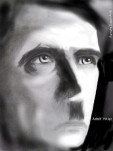
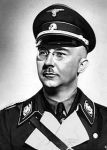
In contrast, by the summer of 1938, the Jews of Germany were living under severe persecution and economic deprivation. Hitler came to power in 1933 and immediately prohibited Jews from being judges, attorneys, journalists, conductors, musicians and professors at Universities. Hundreds of laws were enacted by the German Parliament restricting the lives of Jews, including the elimination of Schita (ritual slaughter of animals). Jews were fired from the civil service jobs and they could not go to cinemas, theaters, swimming pools or resorts.
In 1935 the Nuremberg Laws were passed which prohibited marriage between a Jew and “nationals of German kindred blood.” “The Nuremberg Laws,” states Lucy Dawidowicz, “completed the disenfranchisement of the Jews of Germany.” (War Against the Jews, p. 91) As the summer of 1938 approached, things were looking bleak. In March of 1938, the Germans conquered Austria with no opposition (the “Anschluss”)
The summer of 1938 (July 14, 1938) saw the German Parliament pass the third Decree to Reich Citizenship Law, which defined a Jewish business enterprise as one whose owner is a Jew, thus preparing the way for one of the greatest theft of property in history. In August, Mauthausen concentration camp took its first prisoners.
Nikolaus Wachsmann, in kl: A History of the Nazi Concentration Camps, describes Mauthausen’s watchtowers which were joined together with “vast granite walls that enclosed much of the compound, making it look less like a camp than a forbidding castle.” [kl 163] “By the end of 1938,” Wachsmann continues, Flossenberg held 1,475 men and Mauthausen 994, at a time when Sachsenhausen, Buchenwald, and Dachau held over 8,000 inmates each.” [Id.] Most prisoners in concentration camps at this time were political prisoners and those who posed a “danger” to the Third Reich – could have been Jews but Jews were not the focus of the camps at this time.
The end of the summer brought the Munich Accords, gifting Czechoslovakia to Germany and Chamberlin’s famous line that “there will be peace in our time.”
If it had only been true.
What were your family members doing during the summer of 1938?
SOURCES:
Jewish Transcript, June 17, 1938:
http://jtn.stparchive.com/Archive/JTN/JTN06171938p07.php?tags=treiger
Jewish Transcript, June 23, 1938:
http://jtn.stparchive.com/Archive/JTN/JTN06231933P08.php?tags=treiger
Jewish Transcript July 8, 1938:
http://jtn.stparchive.com/Archive/JTN/JTN07081938p04.php?tags=friedlander
Jewish Transcript, July 22, 1938:
http://jtn.stparchive.com/Archive/JTN/JTN07221938p04.php?tags=staadecker
http://jtn.stparchive.com/Archive/JTN/JTN07221938p04.php?tags=friedlander
Dawidowicz, Lucy S., The War Against the Jews: 1933-1945. New York: Bantam Books, 1975.
Wachsmann, Nikolaus, Kl: A History of the Nazi Concentration Camps, New York: Farrar, Straus and Giroux, 2015.
July 29, 2019
Short Video from Launch of Polish Translation
[image error]
On July 24, at the National Ethnography Museum in Warsaw, Aleksander Czyzewski and I launched the Polish translation of My Soul is Filled with Joy: A Holocaust Story.
Here is a short video put together by my videographer, Gawl Józefczuk.
Aleksander Czyzewski translated for me and is seen introducing me in the video.
You will see Grzegorz Maleszewski standing and speaking and you will see me kind of posing with a group of people – the people in this shot are all descendants of Helena Stys.
Enjoy.
July 11, 2019
Moja Dusza Jest Przepelniona Radoscia: Historia Holokaustu – Will it or Will it Not be Sold at the Auschwitz Museum Book Store?
[image error]
Yes, it’s really in Polish. I know, that is crazy, but it is true.
It was really a family affair – a Czyżewski family affair.
Aleksander translated the book (Joanna read it and told me it’s great), Adam edited and Elżbieta published it through her Warsaw-based company Trygon. How is it possible that one of the few families that I know in Poland could take the book I wrote, that happens to include their own family’s story, and turn it into a beautiful Polish book – like magic. I am full of gratitude to them all for doing such a great job and being part of my life.
[image error]
OK, so now what? Moja Dusza Jest Przepelniona Radoscia will be available for sale at the Treblinka Museum, at the POLIN Museum (I hope-they did not confirm yet), and at a few locations in Krakow: the Jarden bookstore; the bookstore in the High Synagogue; and at the bookstore at the Klezmer Hoise.
I really want to have the book sold at the Auschwitz Museum bookstore as well. The Museum sees two million visitors per year. But I had no idea how to make this happen. So, here is what I did.
The day before the Ride for the Living, our group visited Auschwitz-Birkenau. I took a Polish book with me, thinking I could just stop by the “gift shop,” give them a book and suggest that they might carry it in the store. Well, not so simple.
“There is only one person who makes these decisions,” the saleswoman behind the counter told me, “the Museum Director – Jadwiga Pinderska-Lech.”
“Well,” I asked sweetly, “is she available?”
“She is here today,” she responded, “but she sits in the administrative office building.”
“Oh, where can I find her office,” I innocently asked.
“The building is a red brick building just across from the gas chamber and crematoria,” she responded without flinching. “She sits upstairs on the second floor.”
“OK, thank you,” I stuttered as I left the store.
You must be kidding – the administrative offices of the Auschwitz Museum is just across from the gas chamber and crematoria. Ok, I can do this. Our tour of Auschwitz I, finished up at the exact place I needed to go to find Jadwiga – the gas chamber. I felt super strange slipping away from my somber group as they were about to enter this chamber of death. But I found the red brick building, just across, with a sign on the door – “DO NOT ENTER – STAFF ONLY.” I hesitated, but my nephew Shmuel Treiger was by my side.
“This feels bizarre,” I whispered to Shmuel.
“You can do this Aunt Karen,” Shmuel encouraged, “go, go – now is your chance.”
I slipped away from the group and opened the door that said, “DO NOT ENTER,” knowing that if I had been here 75 years ago, breaking an Auschwitz rule would have led to my death. But then again, as I was entering this forbidden place, my fellow bike riders were walking into the gas chamber!
It was completely silent in this building – it felt creepy and haunted. I ascended the stairs as instructed and walked down the hallway looking for Jadwiga’s name on the office doors. Each office had a closed door and seemed abandoned. I got all the way to the end of the hall and did not find Jadwiga’s name, so I turned around and walked towards the other end. I approached the final door, at the end of the hall, and there it was – her name – Jadwiga Pinderska-Lech. I should have started with the “corner office” as she is the Museum Director, after all.
Well, that was the one door that was slightly ajar. So, I gently knocked, and a woman responded. I entered the large room with light streaming in through the windows with a view of the gas chamber and the chimney from the crematoria.
“I am sorry to bother you,” I said, “I am looking for Jadwiga.”
“I am Jadwiga,” she responded.
“Oh, great,” I said turning on my most charming sales persona. “I am Karen Treiger from the United States. I wanted to give you a book I wrote and just launched in its Polish translation. I was hoping that you might consider selling the book in the Museum’s bookstore.”
Well, we chatted a bit more. I gave her the book and a card and thanked her for her time. I left the building, closing the “DO NOT ENTER” door firmly. I took a deep breath, feeling like what I just did took a lot of chutzpa. As I lifted my gaze, the first thing that greeted me was the chimney of the crematoria – Oy Vey.


My group was already out of area, getting on the bus to travel the short distance to Birkenau. I decided to slip into another group of tourists entering the gas chamber. I needed to enter that space to bring me back to the reality of this place.
Well, that got me back in the “Auschwitz spirit.” Though I have not yet head back from Jadwiga about whether they will carry my book, if they do Sam and Ether’s “spirit” will be among the many ghosts that inhabit this place.
Stay tuned, I will report back.
July 1, 2019
Ride for the Living – 60 Miles from Auschwitz to Krakow
[image error]
[Photo: Me & my cousin Rebecca upon arrival at Birkenau – 8 AM Friday, June 28]
Bernard Offen, a spry 90-year-old, pony-tailed, Auschwitz/Birkenau survivor, stood under the burning sun and described how, as a boy, he watched his father walk down the long path toward the gas chamber and crematoria #5. It was outside the ruins of crematoria #5 that we stood the day before the ride to commemorate and memorialize the murder and suffering of the Jews during the Holocaust. My heart broke as Kel Maleh Rachamim was chanted and as together, we recited the Kaddish.
[image error]
[Photo: Bernard Offen and Jonathan Ornstein on a tandem bike]
Well, the next morning, Bernard and the rest of us (250) were back, but this time, we had bikes and helmets. Our goal – to ride 60 miles from the gate of Birkenau to the gate of the JCC in Krakow. The intention of the ride was to both commemorate and celebrate – we are here, free to ride away from this place in a group of proud Jews. Bernard rode a tandem bike with Jonathan Ornstein, the Executive Director of the 11-year-old Krakow JCC. I think they just rode the first 14 of the 60 miles, but that if I can do that when I am 90, I’ll be pleased.
I was proud to ride together with so many wonderful people, but especially happy to ride with my cousin, Rebecca Seltzer of New York (see photo on top). We share the same great-grandmother who was smart enough to get the hell out of Belarus in 1910. We started slowly, all bunched together with a police escort due to the traffic on the roads surrounding Auschwitz/Birkenau. I was frustrated, as I wanted to go faster, but I used the opportunity to meet some of my fellow riders.

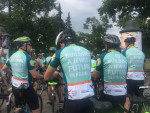
After the first 13 miles, there was a rest stop. There was a camera set up for people to be interviewed, as the JCC is created a film about the renewal of Jewish life in Krakow and the Ride for the Living. I noticed that a young boy was being interviewed and went over to see what he was saying. He was the youngest rider (9-years-old) and like the oldest rider, Bernard, he rode the first 14 miles. He had heard his parents discussing the “big bike ride in Poland” and he told them that he did not want to be left out. So, he came with his parents and grandparents, who at the time of the interview, were not present.
“What would you say to other nine-year-old kids about why they should learn about the Holocaust?”
“Nine-year-old kids should learn about the Holocaust so that they know that life is not always happy,” he answered, “but they should know that life is not always sad.” I was blown away by his answer and then a man came and stood next to me as I was watching this unfold – I turned to him and said – “listen to this kid– he’s amazing” – and the man said – “that’s my boy!” I slapped him on the back and said, “well done.” This young man’s wisdom goes well beyond his years and it was a snapshot of the meaningful things that were discussed and said on this life-enriching ride.
We were set loose to bike at our own speed for the next 36 miles. There was a speedster group in the front, who traveled about 20 miles per hour – too fast for me. But I was faster than the slowest group that gathered in the back. Consequently, I rode for hours by myself – through the Polish countryside – meeting some riders here and there, talking for a bit and then moving on. It gave me plenty of time to assess my complicated feelings about Poland. Every farm I passed (and there were many), I thought of Sam’s family farm in Bagatele. Every small town I passed through, I thought of Esther’s small Shtetl of Stoczek. I wondered what these families did or more likely did not do to help Jews during the war – so close to Auschwitz. The towns nearby could smell the flesh burning – day after day. But the countryside is so peaceful. Some of the locals came out of their houses to gawk at the group of riders passing by. Did they know we were a group of Jews riding from Birkenau to Krakow? I don’t know. But I wondered, if they knew, what they would think?


[photo on left: chickens wandering by the roadside; right – acres and acres of farmland]
I was deeply moved to meet many of the non-Jewish Poles who volunteered for the ride, as marshals riding along with us, as helpers at the rest stops, as people who put our welcome bags together, greeted us with a smile as we reached the Krakow JCC and then greeted us again that evening as we joined for a 600 person Shabbat dinner in the middle of Kazimierz – the old Jewish Quarter of Krakow. The non-Jewish Poles that I met were so happy to be involved with this ride and to meet us and discuss what is going on in Krakow and how they want to help rebuild the Jewish life there – their tiny bit of tikkun.
[image error]
Some characters I met on the ride: Jeff and Sean (photo above) – a grandfather, grandson team from the Boston area – both so sweet and so happy to be doing this together; a New Yorker who married a woman who grew up in Krakow and only discovered that her grandmother was Jewish as a young woman and was welcomed at the JCC to learn about what it means to live as a Jew; Rabbi Steve Moss, the Rabbi of B’nai Israel Reform Temple in Oakdale who gave a dvar torah at the small kiddish for the “locals” at the Old Izaak’s Synagogue on Shabbat morning; Michael and Suzanne Brodsly from CA – Michael was one of my fellow early risers and we had some good schmoozing over coffee. I could go on and on with the wonderful people that I met – but I won’t.
The design of the bike shirt, as well as a sport shirt they gave us as swag, includes a yellow star. At first it seemed disconcerting to put this symbol of discrimination and death on shirts to wear biking or around town. But my discomfort was put to rest by another 90-year- old Holocaust survivor who was there to share her mother’s art. On Shabbat evening, there was an opening of a small art exhibit of work done by Sofia Guttentag-Davidson. Sofia is no longer alive, but her daughter, who survived labor and concentration camps together with her, was there with her own children and grandchildren. The survivor-daughter, who is a tiny, white haired, soft spoken woman, began to speak. I could see that she was overwhelmed with emotion to be back in Poland and to bring her mother’s artwork, painted after the war, to the JCC.
[image error]
No one made a sound as she spoke of being a child with a yellow star on her clothing and how the Nazis had ordered that no Jews could cross any major street. So, to get to school, she had to walk way out of her way. One day, she said to her friend: “I don’t understand, last week it was fine for us to just cross this street and go home from school, but now we are not allowed. I am tired and I just want to go home. Let’s cross the street and go home.” These two Jewish girls with yellow stars as bullseye on their jackets, began to cross the street. All of the sudden they heard someone shout – “Nazis” – and then they heard gunshots – the Nazis were shooting at them because they were Jews crossing a major street, which was against “the law.” They began to run, but her friend was hit and fell to the ground dead. She kept running and made it home.
“I noticed,” she continued, “that yesterday, the riders had a yellow star on their shirts. At first, I was shocked, but my shock turned to happiness because I realized that these people wearing yellow stars are free Jews. They are the future of the Jewish people. My grandchildren are here with me; they are my future; they are our future.”
That sums it up. Thanks for supporting me on this meaningful ride.
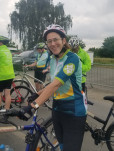

June 25, 2019
Styś, Maleszewski, Ethnography and Apple Cake -how to spend a quiet day in Warsaw
[image error]
· A visit with Eugenuisz and Alina Styś
· Polish book launch in Warsaw
· Apple cake
What shall I start with?
Ok, I’ll begin with my visit to Eugenuisz and Alina Stys.
How to describe my emotions as I opened the door of the car and saw 84-year-old Eugenuisz Stys, with a smile from ear to ear, almost running to greet me? Right behind him was Alina, who has more trouble walking, but was propelling herself towards me. My feelings were a jumble of love, friendship and admiration. With so much history between our families and between us, time melted away and it was if I seen them just yesterday.
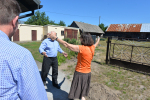
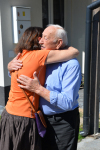
Sitting in their small living room, we talked for two hours about their health, their children, my children, the book, the upcoming event in Warsaw, and of course the Yad Vashem decision not to grant Righteous Among the Nations to Eugenuisz’s family (they are still upset, very upset). Grzegorz Malesewski joined us and it was just like old times – he looked me in the eye and spoke Polish with great enthusiasm as if I understood each word.
[image error]
Of the many things we discussed, one stands out – they tried to describe their feelings when their families would receive packages (they called them “patchkes”) from Sam and Esther in America. After the war, Poland was in the deep freeze of Communism and food, clothing and medicine were all scarce. Alina described a dress that Esther sent to her. It was as if she had won the lottery – she still remembers the details of the dress – the color, the design – and she said she only wore it on Sunday to Church – it was her most precious article of clothing. They described the chocolates that used to arrive and how this was better than Christmas because even on Christmas, they did not have such treats. Grzegorz, who was a boy during these years, said that the feeling in the household when a “patchke” from America arrived, was like nothing he can describe – one of his most joyous memories.
As I listened, I was amazed at the impact that these “patchkes” had on the life of the Stys family – they were almost in tears with just the thought of it. It speaks volumes that Sam and Esther, people of modest means, took their hard-earned money and used it to buy some special gifts for their Polish friends.
Before I met the Stys family, I only thought about the story from Sam and Esther’s perspective – that of the victims of Nazi hate and persecution who lost their families, survived mass murder, lived in a pit, and whose descendants will forever be affected. But, the Stys family was also deeply affected – both during and after the war. Their unabashed excitement at the publication of My Soul is Filled with Joy in Polish did not bring to me tears, but it was close.
This time the Treiger family was well represented – my nephew Shmuel Treiger was with me and, having heard Sam and Esther stories his whole life and having read the book, he was well acquainted with the Stys family before he walked through the kitchen into the small living room with the Christian art on the sparse walls.
[image error]
It was deeply moving to see Shmuel with Eugenuisz and Alina and to show him the barn (had to take a picture of my book in the barn!) and, together with Grzegorz, we walked out to the pit. This walk into the forest was quite different than last time. Eugenuisz did not lead the way and we had some trouble finding the pit. We found it, but only after looking at pictures from three years ago to confirm that it was the right spot. We took lots of pictures so that in the future we can find it again. Shlomo and I have a dream of putting a marker at the pit to commemorate this holy space. Grzegorz will try to find out who owns the property to see if permission can be granted for such a memorial stone.



As I said goodbye to Eugenuisz he said, “I am not sure if I will see up again.” He meant – he may die before I come back to Poland. That made me sad, but it also made me think about how lucky we are to have met all three Stys family members when we did – Janina, Jan and Eugenuisz. As we hugged goodbye – I felt sure that we would see each other again. I hope it’s true.
After returning to Warsaw, I had 30 minutes to change my clothes and get ready for my book event. I wore long white pants with a long sleeve shirt, anticipating that it might be cool in the National Ethnography Museum. But alas, there was no air conditioning in this old beautiful, building and it was hot. Lucky for me there was a fan that pointed at the front of the room – some small relief. Aleksander Czyzewski, the translator of the book and my translator for the evening was ready to go – in a blue suit, white shirt and red bow tie. He looked great.
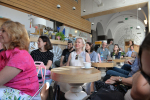
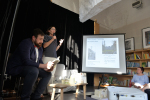
The event was held in the long narrow space just to the left of the entryway, used as the Museum coffee shop. As I approached the front of the space where the screen and projector were stationed, I stopped and stared – there was the book, stacked on a display – in Polish. I picked it up and held it, wondering how exactly I had gotten to this place in life – that I am here in Warsaw selling a book in Polish about my-in-laws. I must be just a little meshuga!
But ok – here I am – as they say in Yoga – try to be present. I tried as I welcomed 30 guests, including Grzegorz, seven descendants of Helena and Aleksander Stys’s family, Joanna Millick’s sister Ula– who was there with some other friends of Joanna–a Priest and a woman who together spend every fourth Sunday at Treblinka reading names of the victims in memory of those who were murdered there, a man whose father used to live in Seattle, and many more interesting people.
[image error]
I spoke for around 45 minutes with Aleks translating. I left out the jokes because I did not think they would translate well. Then I invited Grzegorz up to the front to speak. I decided, since the only non-Polish speakers in the room were Shmuel, Rebecca (my cousin from NY) and myself, that we would not interrupt him for translation to English. I could not understand his words, but I felt his emotion – tears brimmed in his eyes as he spoke. In the room there was a palpable silence as everyone listened to Grzegorz tell his story.
[image error]
I finished up with pictures of our visit to the barn and the pit in 2016 and the video clip of my family singing Shlomo’s song to the Stys family and then Janina singing back to us in Polish. I ended reminding people not to take life for granted, be aware of the choices we make and encouraged people to investigate their own family history.
After the polite applause, I signed a lot of books, took some photos and ate apple cake. The Czyzewski family arranged with the Warsaw JCC to bake apple cake to serve at the event. “Why apple cake?” you might ask. Well, in the book I give a mouth-watering description of Esther’s apple cake – so they decided in Esther’s honor, they would serve apple cake.
[image error]
This is just one small detail that evidences the thoughtfulness of Aleksander and Adam Czyzewski and Ezbieta Czyzewska. The care and attention with which the book was translated, edited and published and the way the book event was crafted and executed is further evidence (if I needed it) of the fine character of this family. I want to say a deeply felt thank you to all of them for being part of my life and for helping me make the dream of a Polish version of the book come true.
Dziękuję Ci!
June 23, 2019
Poland, Take III
[image error]
I stepped out of Warsaw’s central train station and took a deep breath – here I was back in Warsaw – where the Poland part of my journey started exactly three years ago. It was June 2016 that I was here with my family to visit Stoczek and Bagatele and meet the Stys family. As I stepped out of the train station, the imposing Palace of Culture and Science stared me in the face. It’s one of the most distinctive buildings in the world. Though not a pretty building, it somehow speaks to my heart – it says – you are here in Warsaw with its complicated history – before, during and after the war. I knew the way to the hotel – cross the large boulevard and walk three blocks – and there it was – the Polonia Palace Hotel.
[image error]
I entered the lobby and so many memories flooded into my brain. There was the “business center” where I used to sit from 5 to 7 am writing my blog posts. This early morning – I am writing from my room – as sadly, Shlomo is not with me on this trip. The lobby is a small, serene place with welcoming couches and lighting that doesn’t hurt your eyes. It was in the corner of the lobby where I first sat with Marcin Borucki, our guide and translator, as he assisted me in translating the few remaining Stys family letters and where we first bonded over this incredible story. I will be meeting him in the same lobby this morning at 7 am for coffee.


After I got settled in my room, I caught up Aleksander Czyzewski and my nephew, Shmuel Treiger. My cousin Rebecca, from New York, was busy looking around Warsaw, but I was able to say hello and goodnight later in the evening.
I went to bed early – as I was on Israel time – one hour later – and I was exhausted from sitting in the airport all day. I am ready this morning to start the next chapter of this amazing adventure.
But one correction must be made – yesterday’s blog post had a picture of a Priest – but it was not a picture of Father Figiel – here is a proper picture of him:
[image error]
I am sorry he will not be able to come tonight to the talk, but he lives 600 km away from Warsaw! Father Figiel – I will be thinking of you – thank you for being part of this story!
[image error]
[Warsaw – yesterday evening!]
“On Wings of Eagles” – to Poland?
[image error]
Who goes to Israel before Poland?
Not the usual sequence – usually one visits Poland – “one big Jewish graveyard” – and then flies on “the wings of eagles” to Israel, to experience the rebirth of the Jewish people in their homeland. Well, I spent this past week in Israel and today I am traveling to Warsaw – so the answer to the above question is – me.
The sequence is perfect – for the past five days I walked the stone streets of Jerusalem, heard its sounds and inhaled its smells. There is something intoxicating about this city, especially at twilight. Last night, as Shabbat faded, I walked with a friend up the hills to the Jerusalem Theater. From this point, I looked out at the hills as the sunset turned the horizon a light pink and the air was cool and still. My friend encouraged me to see the land as something alive, bringing the past centuries to our present.
Just two nights before, I brought some of Poland’s past to Jerusalem’s present. Speaking at Kehillat Yedidya, I shared Sam and Esther’s story and my journey of discovery.
[image error]
I taught them Shlomo’s song and we sang it together in a deeply moving moment. I knew many in the room (and a few there knew Sam and Esther) and I am so grateful that they came, but many I did not previously know and they are now part of Sam and Esther’s story. One, that I knew, was my cousin David Twersky. He and his wife Tzippy made Aliya some six years ago and I was honored that they were present. David wrote me a note the next morning and gave me permission to share his thoughts:
“Although I read the book, I was newly inspired by Sam and Esther’s story and newly impressed by your ability to tell it. We find many times in Rabbinic writing the expression “אינה דומה שמיעה לראייה” – one cannot compare the clarity of perception that comes from hearing about something with the — much greater — clarity of conception that comes from actually witnessing it. After having read your book and now hearing your presentation, I would like to say that אינה דומה קריאה לשמיעה – one cannot compare the clarity of a story after having read it with the — much greater — clarity acquired after having heard you retell it!
Your in-laws and the people who helped save them were heroes and role models for their children and grandchildren for generations to come and you in your own way are heroic as well for capturing and documenting and publicizing their story as you have done (and as you are doing) for these past four years. May your children be inspired by your own heroism, idealism, and accomplishments just as you have inspired others by publicizing the heroism, idealism, and accomplishments of others.”
But now, I move on – to Warsaw. My flight has been delayed, so I sit here at Ben Gurion airport, writing this blog post, thinking about what it means to travel from Tel Aviv to Warsaw – from the Jewish homeland to the a place that saw so much murder and death, just 75 years ago. But I don’t feel I’m going to “one big Jewish graveyard” – Poland to me has come alive with Jewish life. Over the past four years, I have entered into deep and meaningful relationships with Jews and Christians in Poland in a way that I could never have imagined. I am aware of the disturbing rise of antisemitism, but it does not dampen my excitement and anticipation of what is to come this week.
As I return for my third visit to Poland, I will bring Sam and Esther’s story to a Polish-speaking audience and I will have a book that the Stys family can read. My week will include reunions with Adam and Aleksander Czyzewski and Elzbieta Czyzewska, Eugenuisz and Alina Styś, Grzegorz Maleszewski, Rabbi Michael Schudrich, the Chief Rabbi of Poland, Father Raphal Figel (I hope – he lives far from Warsaw, but said he would try to come to my talk tomorrow night), Jonathan Ornstein, the Executive Director of the Krakow JCC, other members of the Styś family, and my newfound Goldberg cousins. I will be joined in Poland by my nephew Shmuel (Sam) Treiger and my (Steinberg) cousin Rebecca Seltzer – I am honored and excited to have them with me as I launch the Polish translation of my book.
[image error]
[Photo: Esther, Sam and Fay Goldbderg in DP Camp]
The Czyzewski family has been instrumental in making this all happen and I want to thank them in advance – Aleksander for translating the book, Adam for editing and Elzbieta for publishing – and to them for organizing, publicizing, and hosting the event at the National Museum of Ethnography in Warsaw tomorrow night. My journey from Israel to Poland takes me “on the wings of eagles” to see friends and family and to fulfill two dreams that arose in 2016: to give a book to the Stys family; and to bring the story and the book to Poland.
I can’t wait – but I will have to as my plane’s departure is still two hours away.
[photos: Eugenuisz Stys; Father Figel; Jack Goldberg and Aleksander Czyzewski; Krakow JCC; wooden chasidim; Grzegorz Maleszewski]
